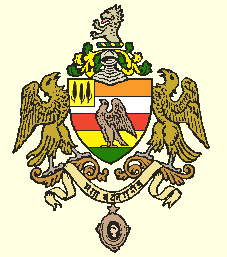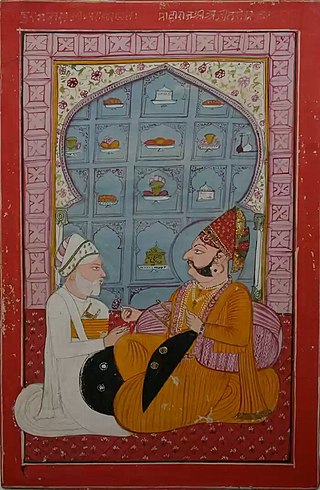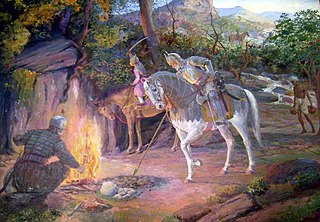
Sawai Jai Singh II, was the 29th Kachwaha Rajput ruler of the Kingdom of Amber, who later founded the fortified city of Jaipur and made it his capital. He became the ruler of Amber at the age of 11, after the death of his father, Mirza Raja Bishan Singh, on 31 December 1699.

The Rathore or Rathor is an Indian Rajput dynasty belonging to the clan that has historically ruled over parts of Rajasthan, Gujarat and Madhya Pradesh.

Ajit Singh Rathore was the ruler of Marwar region in the present-day Rajasthan and the son of Jaswant Singh Rathore.

Durgadas Rathore was the Rathore Rajput General of the Kingdom of Marwar. He is credited with having preserved the rule of the Rathore dynasty over Marwar, India, following the death of Maharaja Jaswant Singh in the 17th century. In doing so he had to defy Aurangzeb, a Mughal emperor. He commanded the Rathore forces during the Rajput War (1679–1707) and played a major role in the Rajput Rebellion (1708–1710) and supported the Maratha ruler Sambhaji in the Siege of Janjira aganist the Siddis of Janjira. He was elected as the leader of the revolt along with Raja Jai Singh II of Jaipur. He won a number of victories against the Mughals and forced many Mughal officers to pay tribute to him in the form of chauth.

Rao Maldeo Rathore was a king of the Rathore dynasty, who ruled the kingdom of Marwar in present day state of Rajasthan. Maldeo ascended the throne in 1531 CE, inheriting a small ancestral principality of Rathore's but after a long period of military actions against his neighbours, Maldeo swept significant territories which included parts of present day Rajasthan, Haryana, Uttar Pradesh, Gujarat and Sindh. He refused to ally with either the Sur Empire or the Mughal Empire.

Sawai Madho Singh I was the Kachwaha Rajput ruler of the Kingdon of Jaipur.He was the younger son of Maharaja Sawai Jai Singh II and younger half brother of Sawai Ishvari Singh.He became ruler of Jaipur after his brother Sawai Ishvari Singh died in 1750.

Maharaja Jawahar Singh was a Jat ruler of the Bharatpur State. He succeeded to the throne when his father Suraj Mal died in 1763.

The Kingdom of Amber, also known as Kingdom of Dhundhar, and Jaipur State, was located in the north-eastern historic Dhundhar region of Rajputana and was ruled by the Kachwaha Rajput clan. It was established by Dulha Rai, possibly the last ruler of the Kachchhapaghata dynasty of Gwalior who migrated to Dausa and started his kingdom there with the support of Chahamanas of Shakambhari in the 12th century. Mostly through 12th to 15th century, the kingdom faced stagnation, sources were scarce. Under its ruler, Raja Chandrasen Amer became a Sisodia vassal and fought in the Battle of Khanwa under Raja Prithviraj Kachhwaha.

Kingdom of Marwar, also known as the Jodhpur State under the British, was a kingdom in the Marwar region from 1243 to 1818 and a princely state under British rule from 1818 to 1947. It was established in Pali by Rao Siha, possibly a migrant Gahadavala noble, in 1243. His successors continued to struggle against regional powers for domination and 9 out of 15 rulers till 1438 died in combat. In 1395, its capital was changed to Mandore by Rao Chunda of Mandore and to Jodhpur in 1459 by Rao Jodha.
The Battle of Maonda and Mandholi was fought between the Rajput rulers of Jaipur and the Jat rulers of Bharatpur in 1767 in Rajasthan. Jawahar Singh of Bharatpur was leading an army back from Pushkar when the forces of Madho Singh of Jaipur met them by Maonda and Mandholi villages, near present-day Neem ka Thana. The battle resulted in the rout of the Bharatpur army by the Jaipur forces.
The Battle of Lalsot was fought between the Rajputs of Jaipur and Jodhpur against Marathas under Mahadji Scindia to collect taxes from the Rajput States. Mahadji as the Naib Vakil-i-Mutlaq of the Mughal Emperor, demanded Rs.63,00,000 from the Jaipur court, however these demands were refused, upon which Mahadji marched against Jaipur with his army. A part of the Mughal army under Hamdani deserted and defected to the Rajput army before the battle.
Ahirwada was a historic region located between the Parvati and Betwa rivers in Central India or modern Madhya Pradesh. It was between the cities Bhilsa and Jhansi. Historically Ahirwada was ruled by members of the Ahir community.
The Battle of Malpura took place in 1800 between the Kingdom of Jaipur and supported by the Kingdom of Marwar against the Kingdom of Gwalior. It was the result of a crisis between the governments of the two sides.
The Mughal–Rajput wars were a series of battles between the Rajput Confederacy and the Mughal Empire. The conflicts originated with the invasion of northwestern India by the Mughal ruler Babur, to which the head of the Rajput confederacy, Rana Sanga, offered staunch resistance.

Abhai Singh Rathore was an 18th-century Indian Raja of the Kingdom of Marwar (Jodhpur).

Bakht Singh or Bakhat Singh was an 18th-century Indian Raja of the Rathore Clan. Born in 1706, he ruled over various domains in the Jodhpur and Marwar states and was a major political force during his life.
The Battle of Bagru was a military engagement fought between multiple Indian kingdoms in 1748 near the town of Bagru, Jaipur, India. The battle was fought during a succession crisis following the death of Jai Singh II, which left Jaipur without effective Madho Singh defeated ishwari Singh in a 6 day with help of Marathas and kingdom of bundi.

The Rajput rebellion began in 1708, due to the harsh treatment of the Rajput Rajas by the Mughal emperor. It erupted into a two-year rebellion that forced the Mughal emperor to sue for peace, give them gifts, and restore the Rajput holdings which had been annexed by the previous Mughal emperor Aurangzeb.

Described variously as the Rajput war, Rathore war of independence and Rathore rebellion, the conflict between Rajputs of Marwar and the Mughals started after the death of Jaswant Singh of Marwar, due to Aurangzeb's attempt to interfere in the succession of Marwar. The resistance to Mughal interference was started by the Rajput nobles under Durgadas Rathore and erupted into an all-out war between the Mughal empire and Rajputs of Marwar supported by Mewar Rajputs. It lasted for almost thirty years. The rebellion reached a climax after the death of Aurangzeb on 3 March 1707 and the capture of Jodhpur by the Rathores on 12 March 1707.












